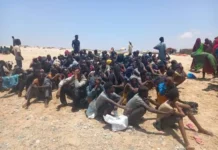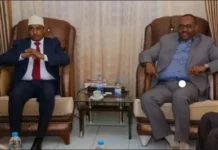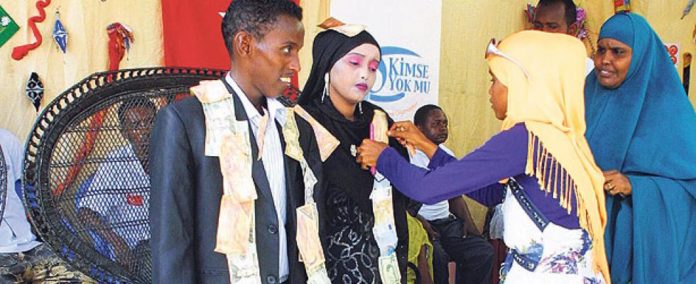Child marriage has been called a human rights violation and a harmful practice, due to the negative consequences for the girl bride and her future children. United Nations Children’s Fund (UNICEF) data show that, in 2011, the proportion of 20- to 24-year-old women married before 18 was 24.1% in Somaliland and 35.2% in Puntland. Social norms – unwritten rules of acceptable behaviour shared by members in a group – have been frequently studied as one of the factors sustaining child marriage. The aim of this paper is to look at how social norms and girls’ agency intersected in sustaining child marriage practices in selected communities in Somaliland and Puntland, offering implications for effective child marriage interventions.
Participants (n=156) in this study were men and women who were recruited from 4 communities in Somaliland (1 rural, 1 urban) and Puntland (1 rural, 1 urban). In addition to individual interviews (n=36), participants (n=120) took part in focus group discussions that were mixed, which allowed the researchers to observe agreements and disagreements between men and women. Focus groups included semi-structured questions and participatory activities, the latter of which can be useful for exploring social norms within groups and the cultural narratives around which those norms are reinforced.
Most participants were against child marriage, suggesting the presence, among adults, of an injunctive norm against it. For example, the majority of participants preferred their children to complete their education rather than get married. However, participants almost unanimously said that child marriage had become more common in their villages over the last decade. Some parents pointed to a change in the power relations between parents and adolescents. This change was motivated by both parents’ reduced presence at home and adolescents’ increased access to internet-enabled smartphones.
Traditionally, parents decided when and to whom their daughter would get married. Participants reported that something had changed: Contrary to what happened in previous generations, their children were now choosing to elope. Participants explained that the increase in adolescents’ capacity to make key marriage decisions was due to a reduction in parents’ influence. Parents were concerned by these elopements; happening outside of parents’ influence and control, they brought shame to families.
Norms that parents should have the final say in marriage decisions played out in unexpected ways. Parents consented to marriages they did not agree with, thus exercising a “façade consent”. This ensured parents were formally the final decision-makers, while dealing with adolescents’ increased freedom to pick their own partners. As the girls’ agency increased, elopement practices appeared to pressure parents into supporting children’s decisions to get married. While, traditionally, parents played a big role in marital decisions, participants reported their diminishing involvement, alongside efforts to maintain their role as parents and have the final say on the matter, in front of peers and neighbours in the community.
The researchers find that 3 factors intersected with adolescents’ increased agency in sustaining child marriage: (i) social norms condemning premarital sex and assigning a greater status to married adolescents, (ii) increased access to the internet (through smartphones), and (iii) poor economic conditions, leading parents to approve of elopements to spare them from having to pay to organise a formal wedding. These contextual factors intersected with adolescents’ agency expansion (partly driven by the availability of new technology) in increasing adolescent-led marriage.
To look more closely at (ii), internet-enabled smartphones offered new opportunities for young people to negotiate and enter into relationships outside their parents’ control. Technology provided a new space where adolescents could “learn about romance and love” (in the words of a male participant) and come to know both that their peers got married and that their friends approved of these marriages (witnessing their peers’ reactions to the news of their friends getting married). This affected their beliefs that marriage would give them status among their peers, eventually influencing their decisions to get married themselves.
Different injunctive and descriptive norms acted simultaneously on parents and adolescents, helping explain the perceived increase in adolescent-led marriage amongst participating communities. One striking feature that emerged from the dataset was the presence of an injunctive norm against child marriage among parents, alongside participants’ belief that child marriage was increasing and initiated by adolescents themselves.
Implications for effective practice to reduce child marriage emerge from the findings, which:
- Challenge the assumption that an increase in adolescents’ agency necessarily improves their health and wellbeing, as this relation is highly influenced by the local system of norms affecting how adolescents exercise agency. Practitioners need to develop a deep understanding of the socio-cultural context in which they want to carry out their interventions.
- Suggest that working exclusively with adolescents might not only be ineffective, but actually harmful. A shift in the normative system can be achieved by facilitating critical conversations across adolescents’ social networks, including their peers, family, and other community members.
- Highlight the importance of designing intervention strategies that integrate awareness of adolescents’ access to modern communication technologies. Practitioners could, for instance, equip parents (especially illiterate parents and those living in rural areas of low- and middle-income countries) with the skills necessary to discuss internet use with their children. At the same time, practitioners could help adolescents look critically at the models they find on the internet and on social media, and to reflect on the potentially harmful consequences of following them blindly.
- Shed light on the need to conduct further research at the intersection between agency, technology, social norms, and child marriage. For instance, future research could look at how agency and technology intersect in ways that shift or maintain existing harmful social norms.
- Raise ethical questions on whether practitioners should respect adolescents’ decisions to get married (when that decision is taken relatively freely), or whether they should work to influence the socio-cultural context so that adolescents wait until they are 18 or older to get married.
In conclusion, this study has found that, in Somaliland and Puntland, within a context of economic deprivation and increased access to technology, norms that sustained child marriage intersect with young people’s increased agency in ways that explain new adolescent-led marriage practices. Interventions that aim to reduce marriage among adolescents living in Somalia (where marriage can be a protective strategy) should integrate a social norms perspective to avoid increasing adolescent-led marriage.







































